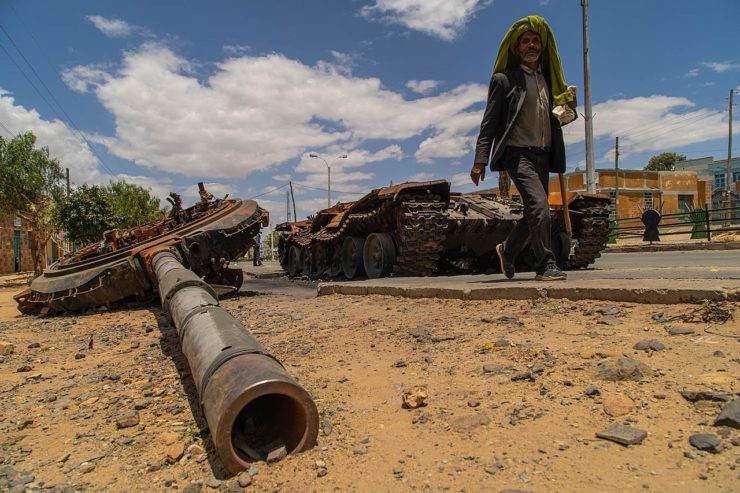
A year ago, any talk of a hypothetical alliance between the Tigray People’s Liberation Front (TPLF) and Fano would have gone no further than greetings, but today the situation has changed. Once at the forefront of the anti-Tigray forces, Fano’s Amharic nationalist organisation has come under attack from its new ally, the Ethiopian government led by Abiy Ahmed, while its former antagonist, the TPLF, has managed to restore peace with the federal centre, albeit at the cost of significant concessions. Such shifts in the balance of power on Ethiopia’s political map raise legitimate questions about the prospects for new alliances, including those that recently seemed rather unlikely.
Taking into account the previous sections which have detailed the current interests and capabilities of the three major political actors in Ethiopia, with the exception of the ruling Prosperity Party, it is possible to compare the position of Fano and the TPLF in the system of political coordinates. Thus, the main task of the Tigrayan clan at this stage remains to compensate for the loss of resources, to maintain political influence in Tigrayan state and to find a favourable solution to the question of the ownership of Western Tigray. However, despite the TPLF’s obvious dependence on the Prosperity Party to achieve at least the third objective, it would be premature to see the party, which until a few years ago occupied the centre of the country’s political firmament, as an actor that has abandoned its ambitions. The fact is that, given the considerable turbulence in the Horn of Africa and Addis Ababa’s desire to move closer to Moscow while maintaining close ties with Washington, external pressure on Abiy Ahmed’s team will only increase, which means that TPLF leaders who once worked closely with the US may be able to reach out for a helping hand from across the ocean. Thus, it should be understood that the TPLF’s current most pressing ‘needs’ do not characterise the party’s true interests and long-term goals, although they do determine its political course in the short and medium term.
From autumn 2023 onwards, Fano’s main objective is to survive – that is, to avoid military defeat at the hands of government forces – and to maintain and strengthen its political position in Amhara Regional State. It is noteworthy that the balance between medium-term objectives and long-term priorities here reflects the situation in which the TPLF is forced to exist: similarly, Fano’s ambitions are not limited to the current goal of controlling part of Amhara Regional State, but extend much further, to the restoration of Amharic dominance in the country’s politics.
As a result, it seems possible to say that while the position of the TPLF and Fano has changed significantly over the past two years, the prospects for a rapprochement between the two organisations remain highly unlikely. These organisations are perhaps the most pronounced and “stable” antagonists in the Ethiopian political system today. The mutual hatred of Amharic and Tigrayan nationalists both reflects the feelings of the general population and serves as an effective mechanism for ethnic mobilisation by the elites. At the level of existing discourses, an alliance between Fano and the TPLF is simply unthinkable, and mutual accusations and ridicule form a central part of any assessment of the situation.
Fano and OLA: two peas in a pod
During the Tigray conflict, Amhara security forces, many of whom later joined Fano, took part in operations against the Oromo Liberation Army (OLA) both in Oromia Regional State and in Oromo-populated areas and woredas of Amhara Regional State. At the time, this information was not surprising: the Amhara nationalists had fully supported the Ethiopian government in its confrontation with the TPLF, while the OLA had allied itself with the Tigray clan. Today, the situation is somewhat different: the OLA continues to fight guerrilla warfare, controlling large swathes of mostly rural Oromia, while Fano has gone from being the closest ally of the Prosperity Party to a near-enemy, having been the target of a major anti-terrorist operation since September 2023.
Even a cursory glance reveals a number of striking similarities in both the political agenda and tactics of Fano and OLA struggles. First, both parties appeal to the ethnic sentiments of the general population, accusing the Abiy Ahmed government of politically marginalising the Amhara and Oromo, respectively. Second, representatives of both organisations acknowledge the existence of an intra-group split: some of the ‘tribesmen’ support the tyrannical regime and therefore deserve to be punished. Thirdly, Fano and the OLA use guerrilla warfare tactics that proved effective in the 1990s, abandoning control of major administrative centres at all costs in favour of sporadic attacks from rural areas. However, there are two fundamental differences that limit the prospects for real cooperation between the two rebel forces.
Firstly, the OLA and Fano are two ethnic groups with a history of tense relations and a number of territorial claims. As such, the prospects for interaction are severely limited by the lack of conditions for grassroots cooperation and the perpetuation of an ‘enemy’ image. In addition, unlike Fano, whose “marginal” status has not yet been firmly established in the political system of coordinates, the OLA is a long-established and predictable organisation whose goals and methods are clear to the government, which opens up additional space for negotiation and compromise.
In this context, it seems logical to conclude that the relative unpredictability of Fano’s future actions, as well as inter-ethnic tensions, limit the possibility of cooperation at this stage. However, if Fano continues to follow in the footsteps of the OLA, the likelihood of coordinating efforts and mitigating conflicts of interest between the two organisations will increase.
Ivan KOPYTZEV – political scientist, research intern at the Centre for Middle Eastern and African Studies, Institute for International Studies, MGIMO, Russian Ministry of Foreign Affairs, especially for online magazine “New Eastern Outlook”